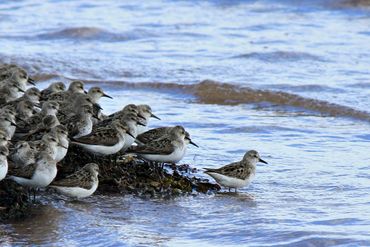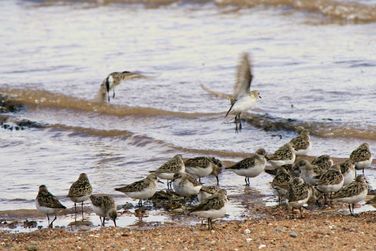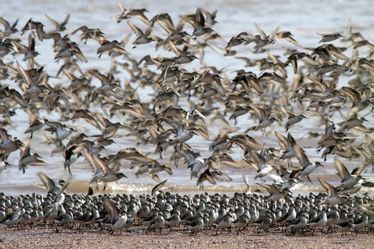
Moving as if to the sweep of a conductor's baton, they flow off the beach like a tide of liquid mercury, then swoop into the air, a dark ribbon smudge against the August sky. As if on prearranged cue, they bank as one and the flock metamorphoses, revealing the flashing white of ten thousand underbellies caught in the glory of the setting sun. A dance of precision and grace.
Mesmerized, I float motionless in my kayak. Like a mirage, the flock turns toward me, skimming the glassy surface of the bay. As their sheer numbers wash over me, I feel the brush of wings on my upturned cheek….but perhaps it is only the breath of their passing.
Then, just as suddenly, they are gone…and I am adrift alone.
 Semi-palmated sandpipers. (Photo courtesy Deborah Carr)
Semi-palmated sandpipers. (Photo courtesy Deborah Carr) Each year, as the summer sun wanes, perhaps as many as two to three million of these aerobatic aviators stop on upper Bay of Fundy shores while on migration from Arctic breeding grounds to the southern tip of South America.
Here in New Brunswick, the main viewing areas are at Mary’s Point, the Hopewell Rocks and Johnston’s Mills (near Dorchester). The birds begin arriving in mid-July; first the female flocks, then the males, followed by the juveniles last…in early August. Is their future path imprinted before birth, or are they led by some unseen guidance?
Here, in the upper reaches of a bay famous for the world’s highest tides, there is something less well known: a small, lipid-rich invertebrate is found in enormous numbers on these tidal mudflats. Commonly known as mud shrimp, these small crustaceans (Corophium volutator) are an important food source for the migrating birds.
 Semi-palmated sandpipers at water's edge. Photo courtesy Deborah Carr
Semi-palmated sandpipers at water's edge. Photo courtesy Deborah Carr Preservation and stewardship of these prime feeding areas has been critical to the survival of the shorebirds.
The Mary's Point Shorebird Interpretation Centre is administered by Nature NB and the Canadian Wildlife Service, Johnson’s Mills Shorebird Reserve and Interpretation Centre is owned and managed by the Nature Conservancy, and the Hopewell Rocks is provincially-owned.
 Photo courtesy Deborah Carr
Photo courtesy Deborah Carr As reluctant as I am to disturb their rest, I long to see their dance once more.
The synchronicity of their flight has captivated birdwatchers and scientists for decades. No single bird appears to lead, but they fly as a single, collective shape, billowing like a silk scarf on the wind. Scientists claim the manoeuvres are evasive techniques intended to discourage predators, such as peregrine falcons and merlins, which can swoop into the flocks, knocking out a single prey.
 Photo courtesy Deborah Carr
Photo courtesy Deborah Carr Peter Hicklin, a biologist with the Canadian Wildlife Service (now retired), has studied these shorebirds since the mid 1970’s. They are his life’s work. Through a banding program, he discovered the same birds together over consecutive years. “They are buddies. They know each other,” he tells me with a grin.
I like this sense of community – how they band together for security and strength. I like that the females make this long journey together. I have already discovered the hardest roads are often best traveled with my women friends. Birds of a feather, and all that.
Their story demonstrates nature’s interconnectedness and this is what draws me back time and time again. Watching them reminds me of my responsibility to the land and its creatures.
 Quietly watching the flocks at Mary's Point. Photo courtesy Deborah Carr
Quietly watching the flocks at Mary's Point. Photo courtesy Deborah Carr The disrupted flock surges towards me with a whirrrr of wings and in that moment, as they flow around me like water on a rock, I feel a certain kinship.
Then in a breath, they are gone and again, I drift alone.
Note: There have been 32 species of shorebirds spotted at Mary's Point. Learn about some of them on the NatureNB website.
 RSS Feed
RSS Feed